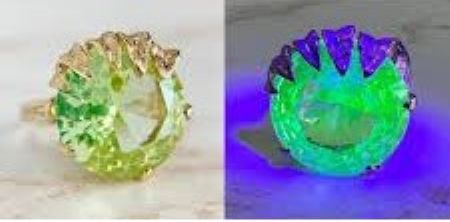The Green Glow Deception: Other Culprits at Play

It's Glowing Fluorescent Green...That Means Uranium Glass! Or does it?
It is a common sight to see individuals in the glass and gem community using UV (black) lights to illuminate their stones, often proclaiming, "This is uranium glass!" if a bright green glow is observed. In many instances, the glow is not bright or even green, yet the mere presence of fluorescence leads some to conclude that uranium must be the cause. However, is this single tool sufficient for accurate identification, or does it require a more comprehensive approach? The answer lies in possessing advanced gemological knowledge and equipment, recognizing that UV test results are merely indicators that should be used along with further testing to reach a conclusion.
Ultraviolet fluorescence is an unreliable standalone property for gem identification due to its variability. Minerals of the same species can exhibit different fluorescence colors depending on their origin. The intensity of fluorescence can also vary, ranging from inert to strong within the same species. Moreover, different minerals can fluoresce the same color, rendering accurate identification based on color alone unreliable.
 |  |  |
| Uranium glass rhinestones. Could be vintage and new. Mostly seen in costume jewelry or crafter/artisan set in new jewelry. | Synthetic spinel, mint green or green. This is what is used in fine jewelry and commercially produced mid century jewelry in gold and silver. Some costume jewelry makers used synthetic gems too. | Modern jewelry from mid 1970s to present for cubic zirconia that is doped with erbium as a colorant for pink and purple. Erbium as well as selenium is also used in glass for a green glow. |
While uranium glass is undoubtedly famous for its green fluorescence, other elements and compounds can trigger a similar effect under UV light, leading to misidentification. Here are some common culprits:
- Manganese: Manganese, particularly when used as a decolorizer, can cause glass to glow a yellow-greenish hue under UV light. This is especially common in antique clear glass, which may appear slightly lavender or amethyst in daylight due to manganese exposure to sunlight.
- Selenium: Selenium can also cause a green glow, albeit typically a weaker and more yellowish-green than uranium glass. It's commonly used in red and orange glass and can sometimes be found in clear glass.
- Modern Glass with UV-Reactive Agents: Some modern glass manufacturers intentionally add UV-reactive compounds to their products to achieve a similar green glow. These agents mimic the effect of uranium without containing any radioactive material.
- Plastic and Other Materials: Certain plastics and other materials can also fluoresce under UV light, adding further confusion to the identification process.
Yet another variable to add to the list, is what wavelength your UV light is. Is it 365nm or 395nm? The fluorescence results will differ and you need to know to which it is. As such, UV testing, in conjunction with other gemological tests, can be a useful tool, but should not be the sole method of identification. You can see below that manganese glass is also commonly misidentified as uranium glass when the wrong UV light is used.

*Want to credit owner of this image, please contact me to add your link.

